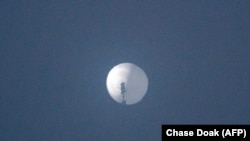Despite China’s insistence it is designed for meteorological research, the United States Defense Department said Friday a high-altitude Chinese balloon sailing over the U.S. is there for surveillance — in violation of U.S. airspace and international law.
At a Pentagon news briefing, Defense Department press secretary Air Force Brigadier General Pat Ryder told reporters he could not go into specifics, but that U.S. defense officials know it is a surveillance balloon and have conveyed their displeasure to Chinese officials on “multiple levels.”
Ryder said they continue to monitor the balloon closely, and while he would not give its specific location, said it was over the center of the continental U.S. and moving eastward. He said it does not present a military or physical threat to people on the ground at this time.
U.S. defense officials discovered the balloon Wednesday over the northwestern state of Montana, which houses one of the three U.S. Air Force bases that operate and maintain intercontinental ballistic missiles. Air traffic out of the Billings, Montana, airport briefly came to a halt Wednesday as the U.S. mobilized fighter jets to track the balloon.
Earlier Friday, a China foreign ministry spokesperson confirmed the balloon did, in fact, belong to China. The spokesperson said it was civilian airship used mainly for meteorological research and “had deviated from its planned course.”
The spokesperson said China regrets the unintended entry into U.S. airspace and will continue communicating with the U.S. about the matter.
Shortly after confirmation that the balloon belonged to China, U.S. officials told reporters on background that U.S. Secretary of State Antony Blinken had postponed a trip to China just hours before he was set to depart. The officials said Blinken did not want the incident to dominate discussions. The scheduled visit was the first for Blinken as secretary of state.
In an interview with VOA’s Mandarin Service, the RAND Corporation’s Timothy Heath said the use of such balloons is considered a relatively outdated mode of collecting intelligence as most nations use satellites to collect such data.
But Heath said new technologies allow balloons to be more easily controlled, and they are often harder to detect by radar. He said the balloon, which is roughly the size of three school buses, also can hover over an area for longer periods of time.
In a separate interview, the Hudson Institute’s Patrick Cronin told VOA’s Mandarin Service the balloon is a “clumsy act of intelligence gathering by the Chinese,” and said the U.S. should prepare an “appropriately sharp response” to the action.
Experts say both the U.S. and the Soviet Union used similar surveillance balloons during the Cold War.
Spy balloons usually operate at 80,000 to 120,000 feet, far above the operating levels of commercial airline traffic and fighter jets.
Some information for this report came from The Associated Press and Reuters.









